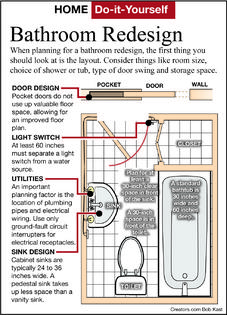Here's How: Remodel Bathroom in Correct Order
Dear James: My elderly mother is moving in, so I need to add another bathroom. What are the major design considerations, and what is the proper sequence of project tasks? -- Javier T.
Dear Javier: Planning the sequence of the work is always a smart step. There are many more considerations when adding a bathroom than when adding other rooms. It is very easy to get ahead of yourself, especially if this is your first time, and then have to rip something back out to do the next part.
As with any major project, always check your local building codes for clearances around the toilet, sink, bathtub/shower, etc. It can vary from locality to locality. Typically, the area where a toilet is located must be at least 30 inches across for adequate clearance. There are also minimum distances from the center of the toilet to other fixtures in the bathroom.
Generally, with a floor made of wooden joists, you should complete the wall framing first and then add the plumbing later. Make sure to position the wall studs so that the center of a stud cavity is at the center of the tub faucet. This allows plenty of clearance around the plumbing and shower valve.
If you are using a concrete floor, for radiant floor heat for example, install the plumbing in the floor first. Radiant floor heating is very comfortable, especially for a bathroom on a chilly morning. Uponor and Heatizon both make excellent hot water radiant floor heating systems. Warmly Yours makes electric floor heating that is very easy to install.
With the walls and flooring completed, it is time to install the bathtub or shower stall. Once the tub is installed, cover it and seal it with plastic film to protect it from abrasive dust created as you work on the drywall and tile. Cover this film with heavy blankets and drop cloths to protect it from dropped hammers and chisels.
If you are going to use forced air heating and cooling, install the ductwork at this time. Next, install electrical wiring, lights and the ceiling exhaust vent fan. To reduce noises from the bathroom, put insulation in all of the interior walls. Using two layers of drywall will also help to block noise.
The last major task is to install the tile around the bathtub or shower stall. Moisture-resistant drywall is easiest to work with, but cement board will hold up better in the long term. Install the tile on the walls and then on the floor. Paint the walls, install the toilet and sink and then add the mirror and towel bar.
Here are a few design tips to consider when planning and constructing your new bathroom:
Consider using cast iron drain pipes for the plumbing for bathrooms on the second floor. Cast iron damps out more of the noise than standard PVC drain pipes.
With all the plumbing, wiring and items inside the walls in bathrooms, the stud placement is critical. Consider using double studs at the shower door frame. Determine where all the items will be located to be sure that studs do not interfere.
Consider building shower shelves in the corner for shampoo, conditioner, soap, etc.
To get adequate water flow with less noise, use 3/4-inch piping for the hot and cold water lines. Run 1/2-inch pipe to the individual faucets.
Make sure to size the ceiling fan properly. If it is too small, it will not draw out enough moisture. If it is too big, it will be excessively noisy. A rule of thumb is that the fan rating in cubic feet per minute (com) should be 1.1 times the square footage of the bathroom.
========
Send your questions to Here's How, 6906 Royalgreen Dr., Cincinnati, OH 45244 or visit www.dulley.com. To find out more about James Dulley and read features by other Creators Syndicate writers and cartoonists, visit the Creators Syndicate website at www.creators.com.
Copyright 2024 Creators Syndicate Inc.






























Comments